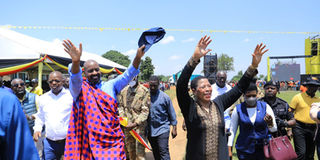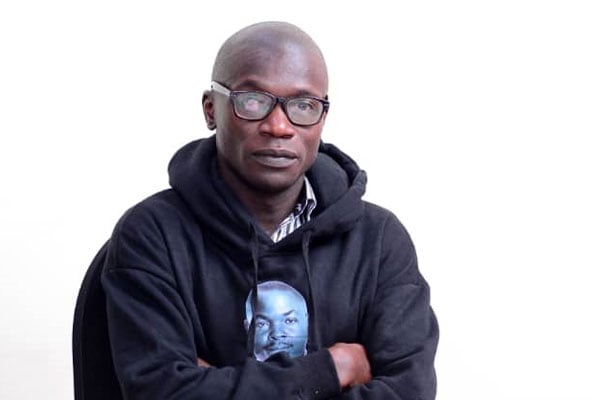Prime
Homecoming parties and the fight to mark territory in sub-regions

Speaker of Parliament Anita Among (right) welcomes First Son, Gen Muhoozi Kainerugaba (front left), to Bukedea District this week. Photo | Courtesy | Speaker press team
What you need to know:
- Strategy. As the political class prepares its self for the 2026 General Election, National Resistance Movement (NRM)-leaning politicians have been organising what they have christened “homecoming” parties. Derrick Kiyonga writes that this is about trying to show that they are kingmakers of their respective sub-regions.
An iconic photo of Speaker of Parliament Anita Among trended as she posed with a group of both the ruling National Resistance Movement (NRM) party and Opposition Members of Parliament (MPs), with her new luxurious upcountry mansion in the background.
The function was billed as her “homecoming”, or “thanksgiving ceremony” but some political commentators say Among had for a long time prepared this function to show President Museveni that she is the most powerful politician in Teso.
“I was invited to the function because the Speaker wants to show that she has the numbers, but I didn’t attend because I don’t attend NRM functions,” says Ibrahim Ssemujju Nganda, the Kira Municipality MP.
As the 2026 General Election beacons, many politicians in NRM from different sub-regions are positioning themselves as the kingmakers in their respective areas of influences as they look to be rewarded by President Museveni, who many think will look to extend his rule beyond 2026.
Historically, western and central regions have produced more ministers than any other region since independence in 1962.
In this thesis titled Museveni’s Centralisation of Power: The Political Economy of Development in Uganda, Nathan Vasher attributes Museveni’s extended tenure to a direct result of his ability to maintain power in Uganda’s fractious society.
While Museveni, who has been in power since 1986, may have rhetorically accepted Western political ideals, Vasher says he has governed according to the underlying political realities of Ugandan society.
“These realities derive from the ethnically divided nature of contemporary Ugandan society. In order to accomplish his desired goals and vision for his tenure, Museveni chose to govern through informal, personal channels as opposed to formal, institutional channels,” Vasher says.
“While on the surface Museveni appeared to be building formal institutional structures that would allow greater influence for the rule of law, he was not. These efforts were merely a façade to cover his network of informal institutions.”
Key among Museveni’s political calculations is how to make up ground that he lost in Buganda to Robert Kyagulanyi’s National Unity Platform (NUP) in 2021.
Museveni didn’t only lose Buganda region by 62 percent, but also all Cabinet ministers lost their parliamentary seats.
Although Museveni has made it clear that he wants to wrestle Buganda back to the yellow column, history indicates that once a President loses this economic nerve centre of the country, it’s very hard to regain it.
For instance, Apollo Milton Obote had a fallout with Baganda after he attacked Kabaka Edward Muteesa’s palace in 1966, and he later abolished kingdoms.
In 1971, Obote was ousted from power by his army commander Idi Amin via a military coup. In 1979, Tanzanian forces ousted Amin from power, giving Obote a pathway to return and contest in the 1980 General Election.

Operation Wealth Creation coordinator, Gen Salim Saleh (left), speaks at Justice minister Norbert Mao’s (centre) homecoming party in Gulu City last month. PHOTO | COURTESY OF RICHARD TODWONG
Buganda hadn’t let bygones be bygones as the anti-Obote mawkishness in Buganda was clearly evidenced by Uganda Peoples Congress’ (UPC) performance in the 1980 poll, which though stolen in the party’s favour, earned it only 15 percent of the vote in Buganda, “winning” in only one out of the 34 parliamentary constituencies.
For instance, in Luweero, Mpigi, and Mubende – which turned out to be the epicentres of Museveni’s 1980-85 guerrilla movement, UPC claimed only 12 percent, 5 percent, and 19 percent of the vote respectively. In fact, Obote didn’t have any illusions about UPC’s electoral prospects in Buganda.
In his August 12, 1980, secret memo to key members of UPC, he laid out a UPC strategy of conduct before, during, and after elections, urging party adherents to remember “…how much the Baganda hate me personally,” further proposing that “the Baganda, especially should be intimidated” for “there is no way their cooperation can be solicited.”
“Obote’s fraudulent return to power in 1980, did not require a lot of effort to prod the population of the Buganda heartland to translate their longstanding and deep-seated abhorrence for the man and his party into open rebellion. The UPC sprang onto the political scene as a party to contain Buganda and, as party leader, Obote had done his best to live up to that mission,” said Sabiiti Mutegeesa, a political analyst, in his paper titled Voting Patterns in Uganda.
Buganda’s history of not looking back explains why Museveni needs kingmakers in other sub-regions as they are critical to the political calculations of the septuagenarian President.
In Teso sub-region, which has about eight districts, Among has for some time directly or indirectly flexed muscle to show that she is kingmaker but, in the process, she has raffled feathers with other NRM politicians who want to be recognised by Museveni.
Jessica Alupo, the Vice President, has clashed with Among the most in the battle of who the most influential NRM politician in Teso is.
This was on display earlier this year when Mike Mukulu, who belongs to Among’s camp, accused Alupo of ignoring the main NRM campaign task force during the Soroti East by-election and chose to work in isolation.
Mukula not only criticised Alupo for avoiding contact with the NRM regional party chairperson, but he also alleged that the Vice President sometimes worked with the Opposition.
Though it was claimed that some supporters of Museveni’s son, Gen Muhoozi Kainerugaba – who is now seen as the person to take over as and when his father gets tired of the presidency – had rejected Among and instead supported Jacob Oboth Oboth for Speakerships last year, the Speaker has moved to mend fences.
After her homing coming fete, she hosted Gen Muhoozi – who has been making rounds in the Teso sub-region and has tested the political temperatures – in Bukedea. Among, who had seen a group of MPs make a long queue to great Gen Muhoozi, declared: “For us in Bukedea here, we believe in the father, the son, and the holy spirit.”

President Museveni (L) with Ms Jessica Alupo (C) and other Teso leaders on his visit to the sub-region in 2019. PHOTO / FILE
Enter Mao
Another politician who is aiming to capture Museveni’s eye is DP president Nobert Mao. Although he claims to be part of the mainstream Opposition, the former Gulu District chairperson last year signed a Memorandum of Understanding (MoU) with Museveni and consequently, he got a Cabinet position as minister of Justice and Constitutional Affairs.
Just like Among, Mao recently had a homecoming fete in Gulu City where Gen Salim Saleh, Museveni’s bother, was among the guests.
The other guests, indicative of the nature of the function, were also NRM bigwigs Richard Todwong, the ruling party’s secretary general, and Deputy Speaker Thomas Tayebwa. Acholi, Mao’s sub-region, in the 1990s and early 2000s was a bastion of the Opposition.
But ever since the Lord’s Resistance Army (LRA) insurgency ended, Acholi sub-region has now been turned into an NRM stronghold.
However, Mao wants to position himself as Museveni’s linchpin in the sub-region and has been talking big about spearheading a national reconciliation effort without showing any results and strides he has taken to achieve the same.
“Because there are many people dividing the people, knowing fully well that when people are divided, they can’t achieve anything. You don’t unite because you love each other socially, you unite because you have a cause,” Mao said at his homecoming fete.
“So, we have a choice so that we have the ability to bargain with the rest of Uganda, particularly the Government of Uganda,” he added.
With the death of Jacob Oulanyah, the former Speaker of Parliament, Mao also positioned himself as the figurehead of the Acholi sub-region.
“It’s time to reconcile. It’s time to forgive one another, and at times unite, but it’s also time to assert ourselves. This is our country. We aren’t second-class citizens and that doesn’t mean we are fighting anybody,” Mao, who represented Gulu Municipality in Parliament from 1996 to 2006, said.
“Anyway, I love a good fight. You all know me. And I think we have been provoked enough. I’m not fighting for myself, I’m now fighting for our children.”
Mao’s call for Acholi to have a quid pro quo relationship with the NRM government bodes well with what Vasher calls the two most prominent features of Museveni’s patronage regime that have led to his centralisation and personalisation of power - decentralisation and the Cabinet.
“Museveni has used decentralisation to purchase northern ethnic loyalty, thus reducing northern elite’s claims to clientelistic support and Cabinet positions to reward southern ethnic loyalty. Not only has Museveni established himself as the provider of benefit in both cases, but has allowed those directly receiving benefits to establish their own economies of affection, ” Vasher says, adding that the establishment of cascading economies of affection further entrenches Museveni’s centralisation of power.





